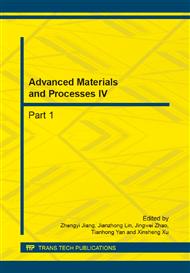[1]
Rios, P. F.; Dodiuk, H.; Kenig, S., Self-cleaning coatings. Surface Engineering 2009, 25 (2), 89-92.
DOI: 10.1179/174329409x373710
Google Scholar
[2]
Wulf, M.; Wehling, A.; Reis, O., Coatings with self-cleaning properties. Macromol. Symp. 2002, 187, 459-467.
Google Scholar
[3]
Fujishima, A.; Honda, K., Electrochemical photolysis of water at a semiconductor electrode. Nature 1972, 238 (5358), 37-+.
DOI: 10.1038/238037a0
Google Scholar
[4]
Fujishima, A.; Zhang, X. T., Titanium dioxide photocatalysis: present situation and future approaches. C. R. Chim. 2006, 9 (5-6), 750-760.
DOI: 10.1016/j.crci.2005.02.055
Google Scholar
[5]
Rios, P. F.; Dodiuk, H.; Kenig, S., et al., Durable ultra-hydrophobic surfaces for self-cleaning applications. Polymers for Advanced Technologies 2008, 19 (11), 1684-1691.
DOI: 10.1002/pat.1208
Google Scholar
[6]
Parkin, I. P.; Palgrave, R. G., Self-cleaning coatings. J. Mater. Chem. 2005, 15 (17), 1689-1695.
Google Scholar
[7]
Matsunaga, T.; Tomoda, R.; Nakajima, T., et al., Photoelectrochemical sterilization of microbial-cells by semiconductor powders. Fems Microbiology Letters 1985, 29 (1-2), 211-214.
DOI: 10.1111/j.1574-6968.1985.tb00864.x
Google Scholar
[8]
Sunada, K.; Kikuchi, Y.; Hashimoto, K., et al., Bactericidal and detoxification effects of TiO2 thin film photocatalysts. Environ. Sci. Technol. 1998, 32 (5), 726-728.
DOI: 10.1021/es970860o
Google Scholar
[9]
Kikuchi, Y.; Sunada, K.; Iyoda, T., et al., Photocatalytic bactericidal effect of TiO2 thin films: Dynamic view of the active oxygen species responsible for the effect. Journal of Photochemistry and Photobiology a-Chemistry 1997, 106 (1-3), 51-56.
DOI: 10.1016/s1010-6030(97)00038-5
Google Scholar
[10]
Tsuang, Y. H.; Sun, J. S.; Huang, Y. C., et al., Studies of photokilling of bacteria using titanium dioxide nanoparticles. Artificial Organs 2008, 32 (2), 167-174.
DOI: 10.1111/j.1525-1594.2007.00530.x
Google Scholar
[11]
Sunada, K.; Watanabe, T.; Hashimoto, K., Studies on photokilling of bacteria on TiO2 thin film. Journal of Photochemistry and Photobiology a-Chemistry 2003, 156 (1-3), 227-233.
DOI: 10.1016/s1010-6030(02)00434-3
Google Scholar
[12]
Fu, G. F.; Vary, P. S.; Lin, C. T., Anatase TiO2 nanocomposites for antimicrobial coatings. J. Phys. Chem. B 2005, 109 (18), 8889-8898.
DOI: 10.1021/jp0502196
Google Scholar
[13]
Bahnemann, D.; Cassano, A., Special issue on TiO2 photocatalytic purification and treatment of water and air - Preface. Journal of Advanced Oxidation Technologies 2002, 5 (1), 3-3.
Google Scholar
[14]
Linsebigler, A. L.; Lu, G. Q.; Yates, J. T., Photocatalysis on TiO2 surfaces-principles, mechanisms, and selected results. Chem. Rev. 1995, 95 (3), 735-758.
DOI: 10.1021/cr00035a013
Google Scholar
[15]
Watanabe, T.; Nakajima, A.; Wang, R., et al., Photocatalytic activity and photoinduced hydrophilicity of titanium dioxide coated glass. Thin Solid Films 1999, 351 (1-2), 260-263.
DOI: 10.1016/s0040-6090(99)00205-9
Google Scholar
[16]
Minabe, T.; Tryk, D. A.; Sawunyama, P., et al., TiO2-mediated photodegradation of liquid and solid organic compounds. Journal of Photochemistry and Photobiology a-Chemistry 2000, 137 (1), 53-62.
DOI: 10.1016/s1010-6030(00)00350-6
Google Scholar
[17]
Asahi, R.; Morikawa, T.; Ohwaki, T., et al., Visible-light photocatalysis in nitrogen-doped titanium oxides. Science (Washington, DC, United States) 2001, 293 (5528), 269-271.
DOI: 10.1126/science.1061051
Google Scholar
[18]
Dunnill, C. W.; Aiken, Z. A.; Pratten, J., et al., N-doped titania thin films, prepared by atmospheric pressure chemical vapour deposition: enhanced visible light photocatalytic activity and anti-microbial effects. ECS Transactions 2009, 25 (8, EuroCVD 17/CVD 17), 65-72.
DOI: 10.1149/1.3207576
Google Scholar
[19]
Bayer, O., The diisocyanate polyaddition process (polyurethanes). Description of a new principle for building up high-molecular compounds. Angew Chem 1947, A59: 257.
Google Scholar
[20]
Kasanen, J.; Suvanto, M.; Pakkanen, T. T., Self-Cleaning, Titanium Dioxide Based, Multilayer Coating Fabricated on Polymer and Glass Surfaces. Journal of Applied Polymer Science 2009, 111 (5), 2597-2606.
DOI: 10.1002/app.29295
Google Scholar
[21]
Lee, C. S.; Kim, J.; Son, J. Y., et al., Photocatalytic functional coatings of TiO2 thin films on polymer substrate by plasma enhanced atomic layer deposition. Appl. Catal. B-Environ. 2009, 91 (3-4), 628-633.
DOI: 10.1016/j.apcatb.2009.06.037
Google Scholar
[22]
Chen, Y.; Yan, L. D.; Yuan, T., et al., Asymmetric Polyurethane Membrane with In Situ-Generated Nano-TiO2 as Wound Dressing. Journal of Applied Polymer Science 2011, 119 (3), 1532-1541.
DOI: 10.1002/app.32813
Google Scholar
[23]
Chen, Y.; Wang, R.; Zhou, J. A., et al., Membrane formation temperature-dependent gas transport through thermo-sensitive polyurethane containing in situ-generated TiO2 nanoparticles. Polymer 2011, 52 (8), 1856-1867.
DOI: 10.1016/j.polymer.2011.02.021
Google Scholar
[24]
Chen, J.; Zhou, Y. M.; Nan, Q. L., et al., Synthesis, characterization and infrared emissivity study of polyurethane/TiO2 nanocomposites. Appl. Surf. Sci. 2007, 253 (23), 9154-9158.
DOI: 10.1016/j.apsusc.2007.05.046
Google Scholar
[25]
Burgess, K. D. Self-Cleaning Titania-Polyurethane Composites The University of Western Ontario London, ON., (2007).
Google Scholar


